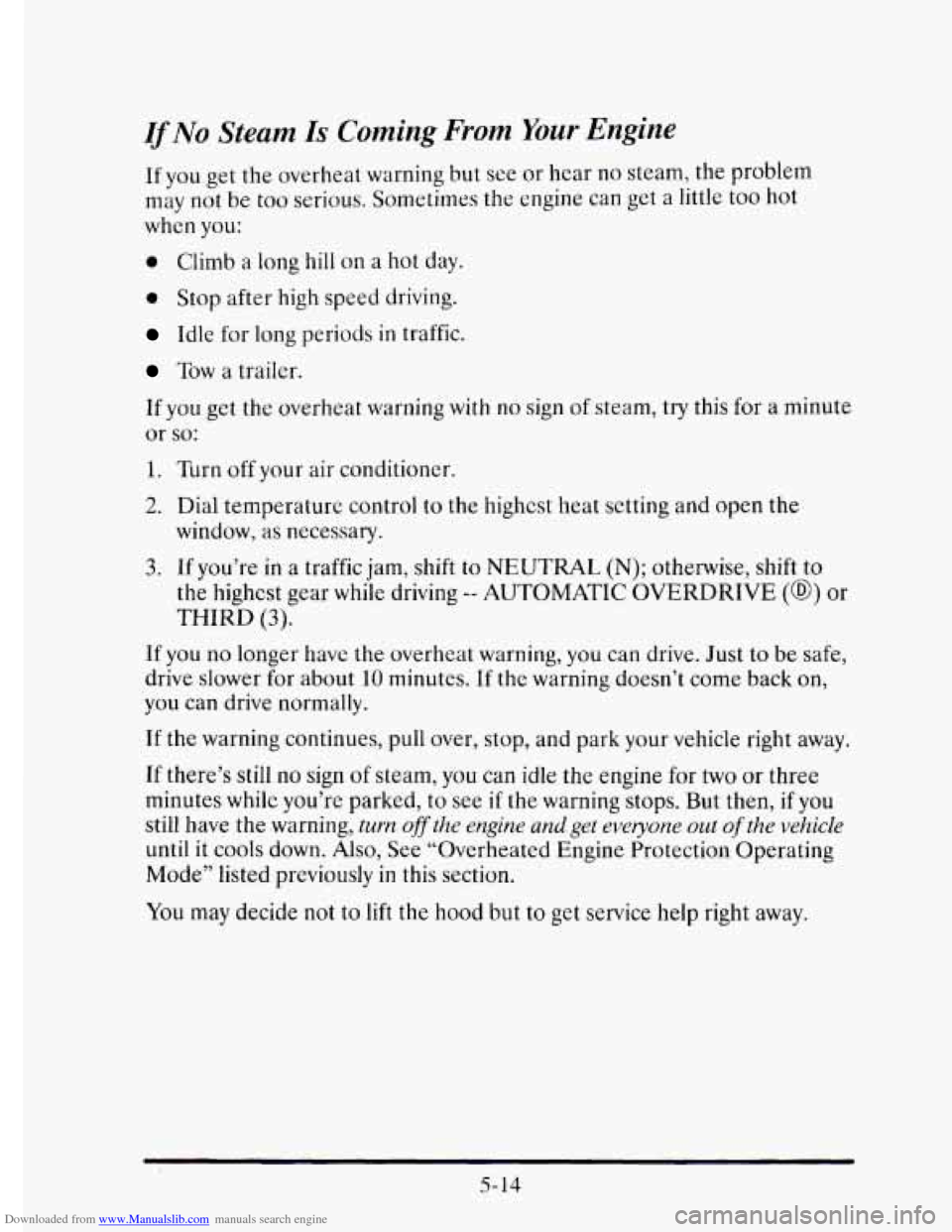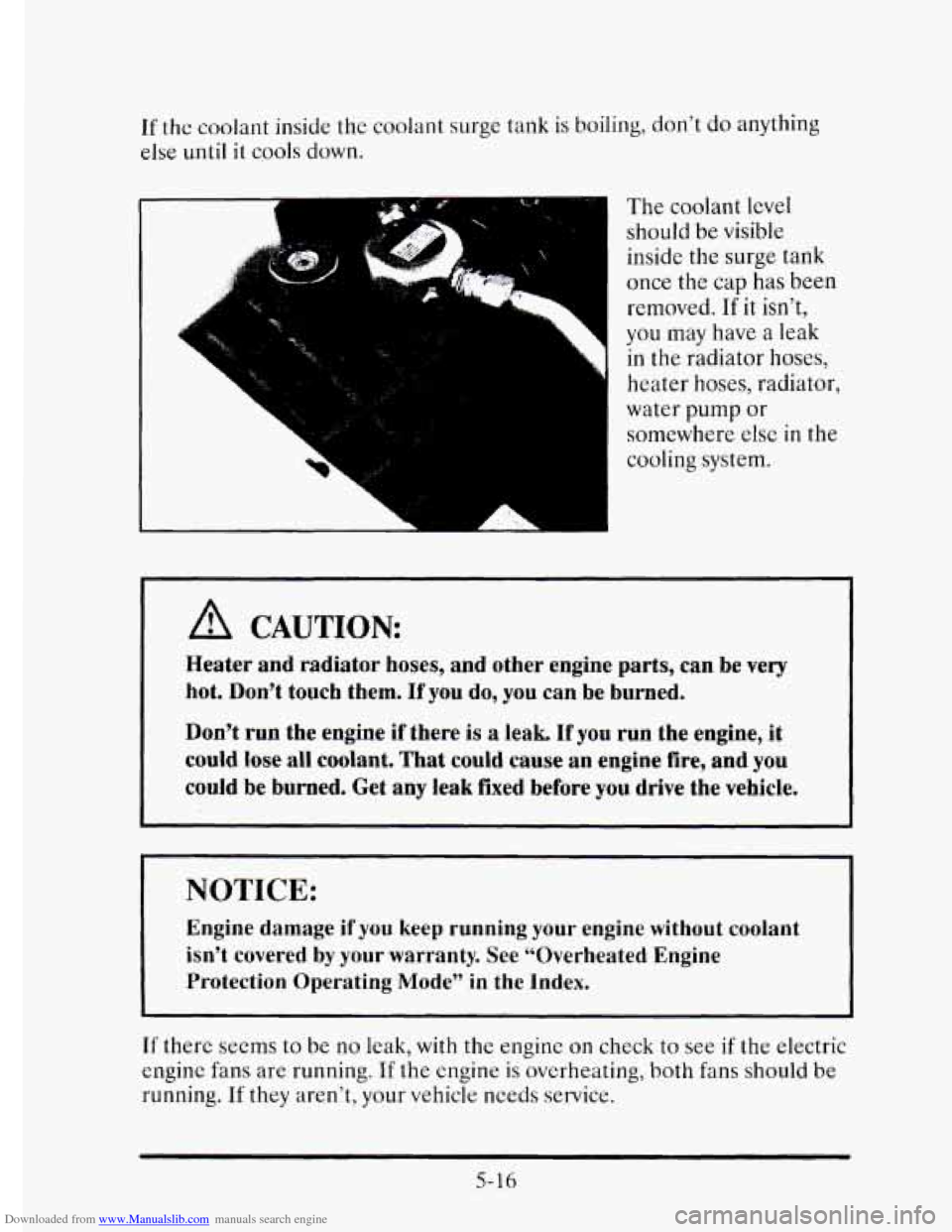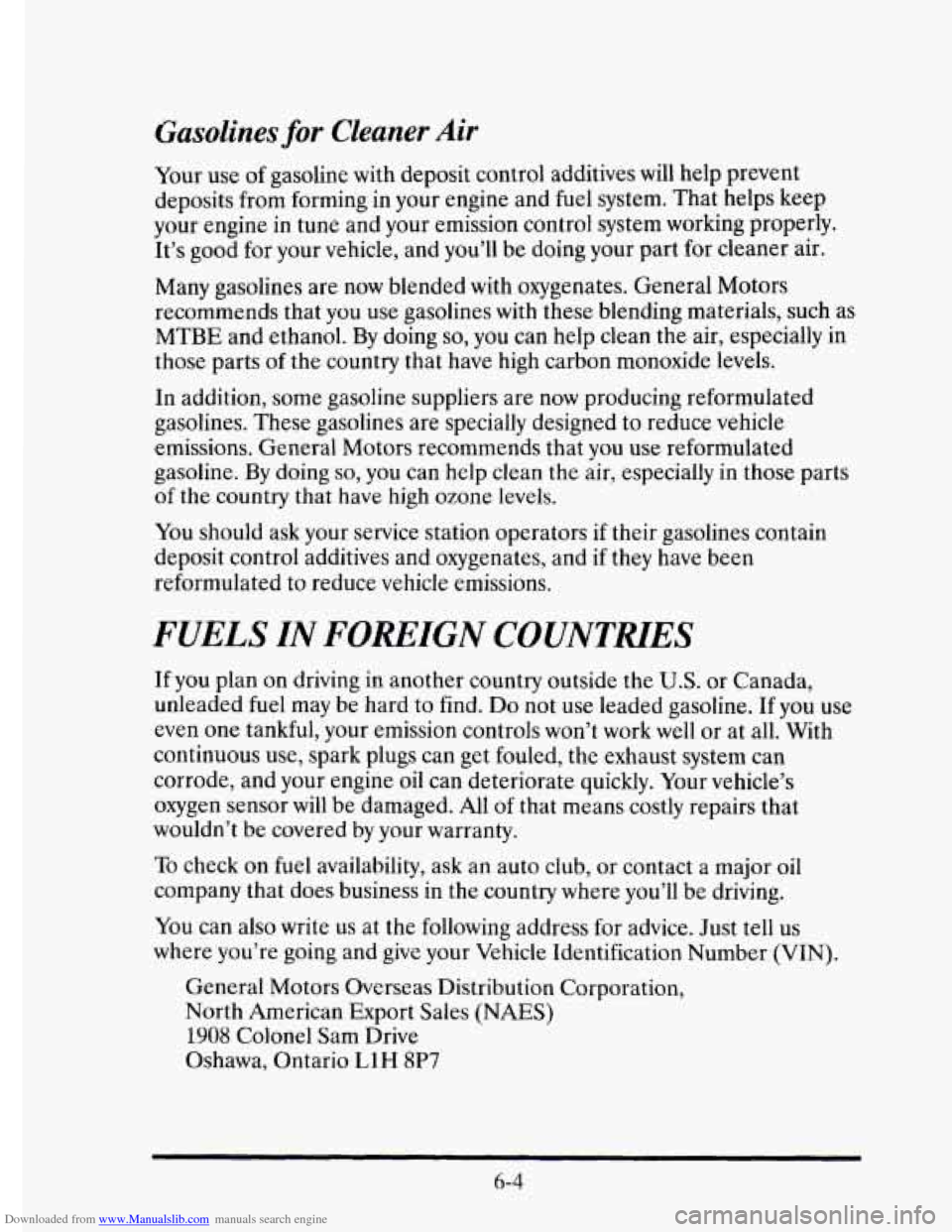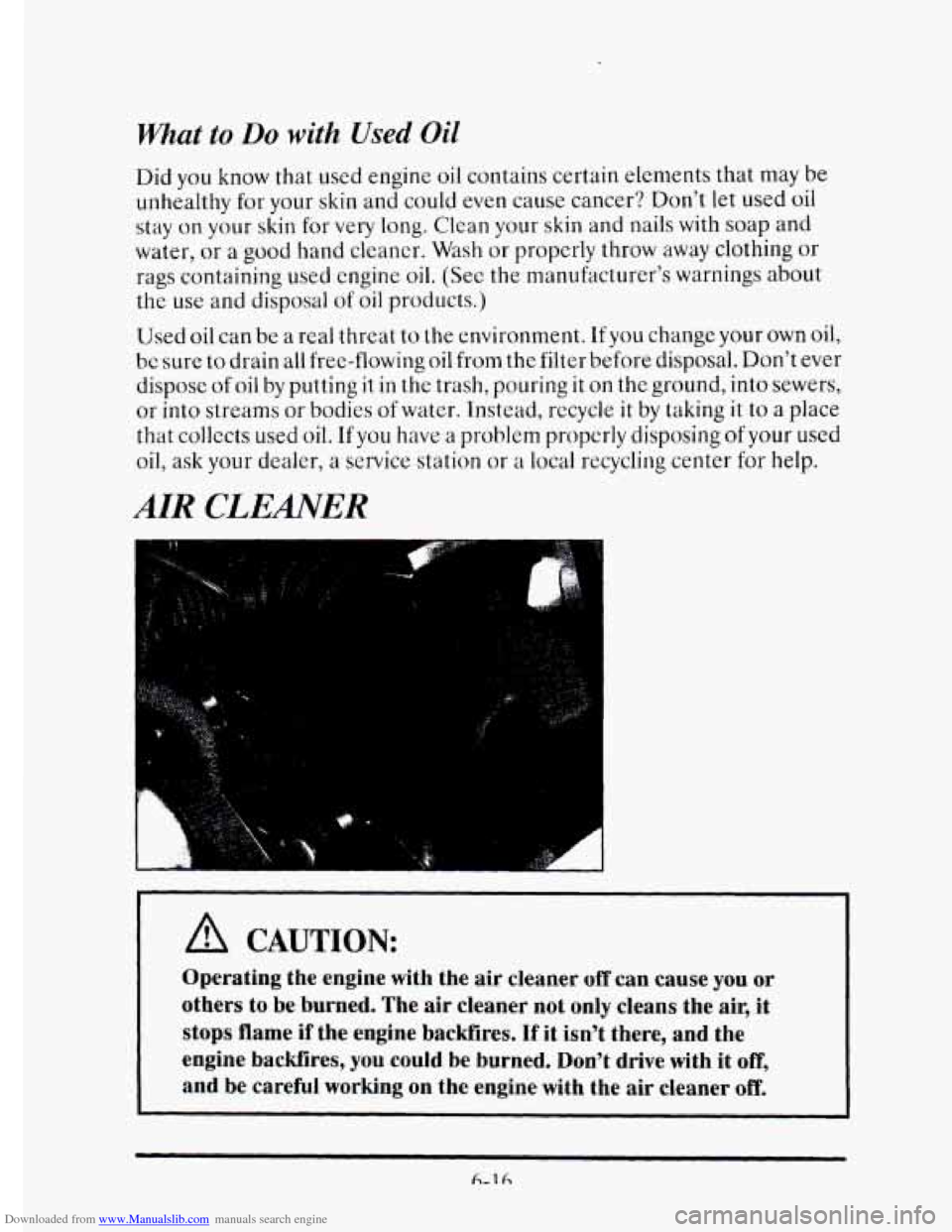Page 238 of 395
Downloaded from www.Manualslib.com manuals search engine When your vehicle is being towed, have the ignition key off. The steering
wheel should
be clamped in a straight-ahead position, with a clamping
device designed for towing service.
Do not use the vehicle’s steering
column lock
for this. The transaxle should be in NEUTRAL (N) and the
parking brake released.
Don’t have your vehicle towed
on the front wheels, unless you must. If the
vehicle must
be towed on the front wheels, don’t go more than 35 mph
(56 km/h) or farther than 25 miles (40 km) or your transaxle will be
damaged. If these limits must be exceeded, then the front wheels have
to be supported on a dolly.
5-1 1
Page 241 of 395

Downloaded from www.Manualslib.com manuals search engine If No Steam Is Coming From Your Engine
If you get the overheat warning but see or hear no steam, the problem
may not be
too serious. Sometimes the engine can get a little too hot
when you:
0 Climb a long hili on a hot day.
0 Stop after high speed driving.
Idle for long periods in traffic.
Tow a trailer.
If you get the overheat warning with no sign of steam,
try this for a minute
or
so:
1. Turn off your air conditioner.
2. Dial temperature control to the highest heat setting and open the
window,
as necessary.
3. If you’re in a traffic jam, shift to NEUTRAL (N); otherwise, shift to
the highest gear wh.ile driving
-- AUTOMATIC OVERDRIVE (@) or
THIRD (3).
If you no longer have the overheat warning, you can drive. Just to be safe,
drive slower for about
10 minutes. If the warning doesn’t come back on,
you
can drive normally.
If the warning continues,
pull over, stop, and park your vehicle right away.
If there’s
still no sign of steam, you can idle the engine for two or three
minutes while you’re parked,
to see if the warning stops. But then, if you
still have the warning, turn off the engine and get everyone out of the vehicle
until it cools down. Also, See “Overheated Engine Protection Operating
Mode’’ listed previously
in this section.
5-14
You may decide not to lift the hood but to get service help right away.
Page 243 of 395

Downloaded from www.Manualslib.com manuals search engine If the coolant inside the coolant surge tank is boiling, don’t do anything
else until
it cools down.
A CAUTION
The coolant level
should be visible
inside
the surge tank
once the cap
has been
removed.
If it isn’t,
you may have a leak
in the radiator hoses,
heater
hoses, radiator,
water pump or
somewhere
else in the
cooling system.
Heater and radiator hoses, and other engine parts, can be very
hot. Don’t
touch them. If you do, you can be burned.
Don’t run the engine if there
is a leak. If you run the engine, it
could lose all coolant. That could cause an engine fire, and you
could be burned. Get any leak fixed before you drive the vehicle.
I NOTICE:
Engine damage if you keep running your engine without coolant
isn’t covered
by your warranty. See “Overheated Engine
Protection Operating Mode”
in the Index.
If there seems to be no leak, with the engine on check to see if the electric
engine fans are running.
If the engine is overheating, both fans should be
running. If they aren’t, your vehicle needs service.
5-16
Page 260 of 395
Downloaded from www.Manualslib.com manuals search engine SERVICE AND APPEARANCE CARE
Here you will find information about the care of your Cadillac. This
section begins with service and fuel information, and then
it shows how to
check important fluid and lubricant levels. There is also technical
information about your vehicle, and a part devoted
to its appearance care.
SERWCE
Your Cadillac dealer knows your vehicle best and wants you to be happy
with it. We hope
you’ll go to your dealer for all your service needs. You’ll
get genuine GM parts and GM-trained and supported service people.
We hope
you’ll want to keep your GM vehicle all GM. Genuine GM parts
have
one of these marks:
n
Delco
6- 1
Page 261 of 395

Downloaded from www.Manualslib.com manuals search engine Doing Your Own Service Work
If you want to do some of your own service work, you’ll want to get the
proper Cadillac Service Manual.
It tells you much more about how to
service
your Cadillac than this manual can. To order the proper service
manual, see “Service Publications”
in the Index.
Your vehicle has an
air bag system. Before attempting to do your own
service work, see “Servicing Your Air Bag-Equipped Cadillad’ in the
Index.
You should keep a record
with all parts receipts and list the mileage and
the date of any service work you perform. See “Maintenance Record” in
the Index.
A CAUTION:
You can be injured if you try to do service work on a vehicle
without
knowing enough about it.
Be sure you have sufficient knowledge, experience, and the
proper replacement parts and tools before
you attempt any
vehicle maintenance
task.
Be sure to use the proper nuts, bolts and other fasteners.
“English” and “metric” fasteners can
be easily confused. If
you use the wrong fasteners, parts can later break or fall OR.
You could be hurt.
NOTICE:
If you try to do your own service work without knowing enough
about it, your vehicle could be damaged.
Page 263 of 395

Downloaded from www.Manualslib.com manuals search engine Gasolines for Cleaner Air
Your use of gasoline with deposit control additives will help prevent
deposits from forming
in your engine and fuel system. That helps keep
your engine in tune and your emission control system working properly.
It’s good for your vehicle, and you’ll be doing your part for cleaner air.
Many gasolines are now blended with oxygenates. General Motors
recommends that you use gasolines with these blending materials, such as
MTBE and ethanol. By doing so, you can help clean the air, especially in
those parts
of the country that have high carbon monoxide levels.
In addition, some gasoline suppliers are now producing reformulated
gasolines. These gasolines are specially designed to reduce vehicle
emissions. General Motors recommends that
you use reformulated
gasoline. By doing
so, you can help clean the air, especially in those parts
of the country that have high ozone levels.
You should ask your service station operators if their gasolines contain
deposit control additives and oxygenates, and if they have been
reformulated to reduce vehicle emissions.
FUELS IN FOmIGN COUNTMES
If you plan on driving in another country outside the U.S. or Canada,
unleaded fuel may be hard to find. Do not use leaded gasoline. If you use
even one tankful,
your emission controls won’t work well or at all. With
continuous use, spark plugs can get fouled, the exhaust system can
corrode, and your engine oil can deteriorate quickly. Your vehicle’s
oxygen sensor
will be damaged. All of that means costly repairs that
wouldn’t be covered
by your warranty.
To check on fuel availability, ask an auto club, or contact a major oil
company that does business in the country where you’ll be driving.
You can also write us at the following address for advice. Just tell
us
where you’re going and give your Vehicle Identification Number (VIN).
6-4
General Motors Overseas Distribution Corporation,
North American Export Sales
(NAES)
1908 Colonel Sam Drive
Oshawa, Ontario
L1H 8P7
Page 275 of 395

Downloaded from www.Manualslib.com manuals search engine What to Do with Used Oil
Did you know that used engine oil contains certain elements that may be
unhealthy for your
skin and could even cause cancer? Don't let used oil
stay
on your skin for very long. Clean your skin and nails with soap and
water, or a good hand cleaner. Wash
or properly throw away clothing or
rags containing used cngine
oil. (See the manufacturer's warnings about
the use and disposal of oil products.)
Used
oil can be a real threat to the environment. If you change your own oil,
be sure to drain all free-flowing oil from the filter before disposal. Don't ever
dispose
of oil by putting it in the trash, pouring it on the ground, into sewers,
or into streams or bodies
of water. Instead, recycle it by taking it to a place
that collects
used oil. If you have a problem properly disposing of your used
oil, ask your dealer, a service station or a local recycling center for help.
AIR CLEANER
11
A CAUTION:
Operating the engine with the air cleaner off can cause you or
others
to be burned. The air cleaner not only cleans the air, it
stops flame if the engine backfires. If it isn't there, and the
engine backfires, you could be burned. Don't drive with it off,
and be careful working on the engine with the air cleaner off.
Page 279 of 395

Downloaded from www.Manualslib.com manuals search engine How to Check
Because this operation can be a little difficult, you may choose to have
this done at your Cadillac dealership Service Department.
If you do it yourself, be sure to follow all the instructions here, or you
could get a false reading on the dipstick.
NOTICE:
Too much or too little fluid can damage your transaxle. Too
much can mean that some of the fluid could come out and fall
on hot engine parts or exhaust system parts, starting a fire. Be
sure to get an accurate reading if you check your transaxle fluid.
Wait at least 30 minutes before checking the transaxle fluid level if you
have been driving:
When outside temperatures are above 90°F (32'C).
0 At high speed for quite a while.
0 In heavy traffic -- especially in hot weather.
While pulling a trailer.
To get the right reading, the fluid should be at normal operating
temperature, which is
180°F to 200°F (82OC to 93°C).
Get the vehicle warmed up by driving about 15 miles (24 km) when
outside temperatures are above
50°F ( 10°C). If it's colder than 50°F
(lO"C), you may have to drive longer.
To check the fluid level
Park your vehicle on a level place. Keep the engine running.
With the parking brake applied, place the shift lever in PARK (P).
With your foot on the brake pedal, move the shift lever through each
gear range,
pausing €or about three seconds in each range. Then,
position the shift lever in PARK (P).
0 Let the engine run at idle for three to five minutes.
6-20